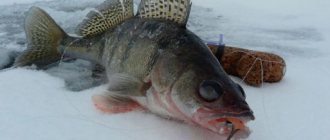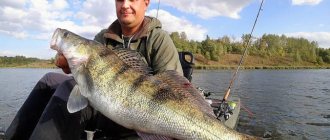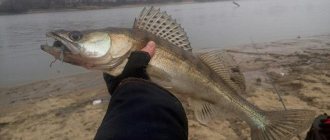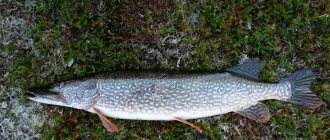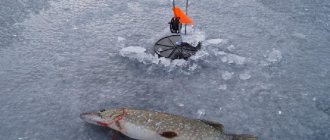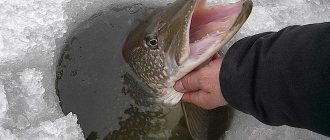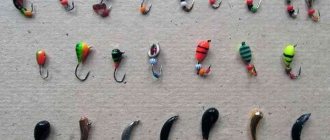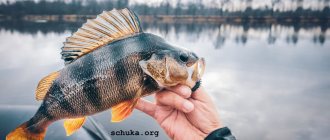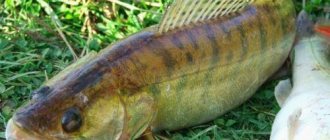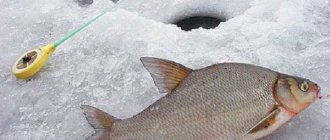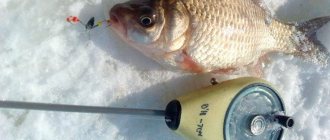It’s no secret that jigging is one of the favorite fishing methods for many spinning anglers. They fish with jigs in small rivers, quarries, lakes, and in large rivers and reservoirs. Using jig baits of various types, colors and sizes you can catch pike, perch, pike perch, bersh, chub, catfish, asp, and in some reservoirs, for example in the Kuban, even rudd. In this article I will try to talk about the technique and tactics of jig fishing pike perch. So, what is fishing for pike perch with a jig and how to properly catch a fanged predator.
Tackle
In order to make it more convenient to further classify gear for catching pike perch, we will single out three main types of reservoirs on which fishing takes place:
- bodies of standing water (reservoirs);
- with medium flow (Moscow River, Oka);
- with a fast current (Akhtuba, Volga).
In addition, let’s take into account the circumstances that fishing for pike perch can take place both on open and overgrown shores, as well as from a boat. Now, in order.
Rods
When fishing in reservoirs on open banks, rods with a length of 3 to 3.3 m with a test weight of 5-25.7-28 g are used. (on average from 5 to 30 g), on overgrown trees and shrubs - with the same tests, but already 2.4 - 2.7 meters long. In addition, for fishing near edges, rods of various lengths with a test weight of 0-10 g can be used.
On medium-current reservoirs, for fishing on open banks, rods with a length of 3 to 3.3 m with weights ranging from 7 to 40 g are suitable; on overgrown banks, it is more advisable to use rods with a length of 2.4 to 2.7 m. Fishing pike perch for spinning in shallow water, in whirlpools allows you to use rods with a weight of 2 to 20 g.
In cases where you have to catch pike perch on the Volga, Akhtuba or other rivers with fairly fast and powerful currents, you will need rods with a weight of 20 to 150 grams and a length of 3.3 - 3.6 meters.
As for the spinning rod action, on reservoirs, in cases where long casting is not needed, you can get by with rods with a Medium action, but on rivers it is advisable to have Fast rods. The point here is that on reservoirs with a strong current, rods with a Medium action will stop working on the load falling to the bottom, and the tip will be constantly “pressed” to the water. The difference in rods when fishing for pike perch with a jig from a boat will only be in length (usually it ranges from 1.8 to 2.7 m), the tests in accordance with the conditions are the same as when fishing from the shore.
Reels
When fishing for pike perch, spinning reels are used with a line capacity (monofilament - since the markings on the spool are in monofilament) from 100 m with a diameter of 0.2 mm to 200 m of the same diameter. That is, mainly reels of the 1000, 2000 and 3000 series. Accordingly, the “thousander” is for fishing in still water, in cases where long casting is not required, and is perfect for gear for pike perch, and the “three-thousander” is already on rods with a length of 3 m for long casts, in the current.
When fishing on the Volga and Akhtuba, reels up to the 5000 series can be used, depending on the length and test of the rod. It is better to purchase cords in unwinding lengths of 150 meters or more, and take up the extra space on the spool with backing, winding an old monofilament under the cord. The gear ratio of the coils is from 5:1 - 6:1, the power on the handle is from 2.5 kg and above.
Cords
For fishing in still water, cords with a diameter of 0.06 mm to 0.12 mm are used with baits up to 12-14 g (sometimes up to 20 g, when fishing holes up to 10 m deep). On the average current, braids from 0.1 to 0.16 are used (Moscow River, Oka River), on strong currents (Volga, Akhtuba) from 0.12 to 0.2 mm. When fishing in a current, it is advisable to use round braids (they float less), and in still water, flat lines are also quite suitable.
Lures
On still water, weights from 0.5 to 7-8 g are used (in pits up to 14-16 g), on average flow, weights from 10 to 28 g are used (on the Oka and Moscow rivers there are places where you have to use weights up to 35 g.), in strong currents (Volga, Akhtuba), weights from 22 to 150 g are required (here, such a spread in weights arises due to the variety of fishing places). To catch pike perch, almost the entire arsenal of jig baits is used: various twisters and vibrotails, octopus and mandula, a variety of foam fish. The size can be any, from small baits, 2 centimeter twisters, to large fifteen centimeter vibrotails. The most catchy baits are natural colors: green, white, yellow, orange, pearlescent, acidic, transparent baits and various colors in combination with sparkles (usually green).
Choosing a spinning rod for fishing from a boat
It is important to note that in this situation, you can use a shorter and more powerful rod compared to what is usually used for shore fishing. For this method of fishing, the casting distance is not particularly important, so spinning from a boat can be selected based on other criteria.
Usually, when fishing from a boat at depth, you count on larger fish. Therefore, instead of a long spinning rod, it is advisable to use a shorter and stronger one. For boat fishing, it is also important that there is not much space in it, there is no opportunity for sweeping movements when casting a spinning rod.
Length
2.6 meters is the optimal length for a boat rod. Shorter options will also be effective (we can talk about 150 - 180 cm).
- On small bodies of water, a length of 1.4 - 1.8 m will be most suitable;
- From 1.8 to 2.1 m - on medium and large reservoirs and rivers;
- Any longer blanks will be effective in large areas of water and offshore areas. Such large rods will allow you to make ultra-long, but at the same time accurate casting. Plug rods often have these dimensions, usually consisting of three legs.
The advantage of maximum length blanks is that they prevent fish from tangling the line in the water around the boat's anchor chain.
Build
Action characterizes the degree of flexibility of a fishing rod. For fishing from a boat, it is recommended to use medium or fast. A rod that is too flexible and elastic will not be useful here. It is more convenient to swim closer to the fishing spot than to cast from afar.
Test
In different cases, a special test may be required. It is better to choose it equal in weight to the model of spinner that is supposed to be used in the fishing process.
For deep lakes, a test of at least 20 g is usually used. If fishing takes place on rivers, then it should be a little heavier: from 25 grams or more.
Techniques and tactics of fishing from a boat
Pike perch on a large river, for example on the Volga, often lives in deep holes under a steep bank and in snags, so you can’t do without a boat on the Volga. The technique for catching pike perch from a boat is usually as follows. During slow rafting downstream with a spinning rod, the bottom is tapped using a jig bait. Usually, pike perch stands at changes in depth and bites often occur in these places. Thus, fishing on a large river, on the Volga or Don from a boat can bring good catches.
Catching pike perch with jigs on reservoirs differs from fishing on the Volga. You have to cover large spaces and you can’t do without an echo sounder. Having found a promising place, they begin to fan-fish the area they like. Typically, a stepwise technique of bait placement is used. Fishing for pike perch in reservoirs requires a lot of time to find a promising place, but once you find one and “enter a point” into the navigator, you can get good catches more than once.
How to choose a fly rod for fishing from a boat
The situation becomes more complicated during the height of the summer heat, when there is less water in the reservoir and it moves away from the shore. In this case, using a fly rod can make fishing more effective.
- In most cases, a blank from 3 to 5 m is taken. In this case, it is possible to make a successful cast without swimming too far from the shore. This increases the angler's maneuverability.
- The tuning is usually medium or medium-fast. For larger fish, using a slow action will be more effective. This will help guide the fish without sudden jerks. Also in this case it is convenient to make a smooth hook.
- A test for catching fish weighing one kilogram can be taken in the range from 10 to 30 grams. It depends on the weight of the fish.
- The number of elbows must correspond to the size of the fishing rod used.
We must take into account:
- How important are casting range and accuracy for this type of fishing? The first parameter depends on the size of the form. In the second case, accuracy is determined by how well the test for a given fishing rod matches the weight of the bait used.
- The comfort of the fishing process itself is of great importance. There is not much space on the boat, and the boat is also unstable.
- It is important that the type of fishing rod is optimal for catching the desired fish. If we are talking about large specimens, a long fishing rod will provide more opportunities to hold the predator.
- When fishing from a boat, it is better if the spinning rod is equipped in advance. At the same time, its type, shape and size must be such that it is comfortable to move with them across the surface of the water in order to search for the most catchable place in a given reservoir.
Showed themselves well:
- Fiberglass forms. Heavy and soft, durable, do not require special storage conditions.
- Made from carbon fiber. Tough, light and durable. At the same time, they will be much more expensive than other options and they need to be stored taking into account special requirements.
- Made from composite. Their specific features depend on the exact composition of the material used.
Method of fishing a place from the shore
Jig fishing begins with choosing the weight of the bait.
When we arrive at the fishing spot, we first attach a heavy load and cast as far as possible. If the bait drags along the bottom when reeling in, lighten the load and again make a long cast. We lighten the load until the load begins to rise from the bottom on the reels and the pause in the fall becomes equal to 1.5-2 seconds (after 1-2 turns of the reel handle). After this, we begin to experiment and change baits, change color, size, type; We try twisters, vibrotails, octopus, foam rubber of several sizes and colors, since jig fishing is a constant experiment. Catching pike perch with a jig from the shore also involves stepwise retrieval. The technique is as follows: after casting the bait, wait until it sinks to the bottom. After this, we make 2-3 turns of the reel handle and wait for the bait to sink to the bottom again, and so we lead the bait to the shore. The bite most often occurs during a pause, but can occur both when the bait is lifted from the bottom, and while the bait is moving. Sometimes pike perch can follow the bait for quite a long time and grab it literally “under the feet” of the angler.
Choosing a fishing spot
To catch a pike perch, a spinning angler needs to know its possible stopping places. On the lower Volga, flocks of predators can be found:
- in deep, snagged holes;
- in local areas with complex bottom topography;
- in the area of channel edges;
- on reaches with a hard bottom and a depth of 3–5 m.
Snags and places with difficult terrain are permanent havens for the fanged predator. Here it can be caught at any time of the year. Areas near channel edges delight spinning anglers with frequent bites in the spring and autumn. In the summer, at dawn, pike perch often comes out to feed in shallow reaches.
Excellent places for fishing for pike perch are located near the Sazanya Bay base, located next to the famous Volga peals. Here you can always rent cozy living quarters, rent a watercraft and use the services of experienced rangers.
Successful fishing for pike perch using a jig from a boat in Astrakhan is only possible if you have a reliable watercraft with a powerful motor. When fishing from the shore, the spinner's capabilities will be greatly limited, which in turn will sharply reduce the number of bites.
TAGS:
Pike-perch parking areas
In the early morning, pike perch prefers to be closer to the shore (on the 1st and 2nd edges); during the day, “shelling” of long distances and the riverbed area begins. Towards evening there was another shelling from the riverbed to the 1st and 2nd edges. It is also important to take into account the direction of the wind; catching pike perch with a jig is more effective from the leeward shore. Pike perch loves holes, which are quite deep, with a hard bottom: sandy, pebble or clay; It has been noticed that pike perch does not like to stay on the bottom with the presence of silt. Has a positive attitude towards snags. It can only enter the grass during spawning of bleak, its favorite delicacy. Likes to stand on stones, in holes, at the entrances and exits of them, near the remains of railway embankments and bridges.
The most favorite depths are 3 m or more; they often follow the fry into shallow water, especially at night. It is easy to detect the hunting location of a flock of pike perch by the seagulls flying above the water: the pike perch squeezes the fry to the surface, and the seagulls attack the fry from the air. When reaching the point, a fan-shaped “lumbago” of the surrounding space begins, taking into account that while guiding the current, the bait is carried to “interesting” places.
- Bends in the river
- Fall into depth
- Pit
- Mounds
Features of fishing from a boat
Fishing from a boat has its own characteristics:
- When the fisherman is not in the central part of the vessel, but at the stern or bow, it will be convenient to cast a spinning rod directly from behind the back.
- If fishing takes place at great depths, the fisherman should not reel in the reel immediately, but in several steps, pausing between them.
- When casting in shallow places, the bait should be cast without waiting until it reaches the bottom, but immediately when immersed in the water.
- If you use vertical fishing while the vessel is drifting, then the most promising fishing rod is short and powerful.
- It makes sense to fish where there are dense thickets of algae, snags, boulders or various massive objects lying on the bottom.
- If it happens in late autumn, then the place where you can catch a large fish may be a distant dump of an underwater hole.
Biting and fishing
Pike perch bites can be divided into three types:
- bite with a blow;
- hanging (if he takes the bait after him);
- chasing after the slack line (when the pike perch, after hitting the bait, goes forward with it, this is how a large pike perch usually bites).
Hooking should follow immediately after detecting disturbances in the movement of the bait; when biting with a slack line, hooking with the rod is done while simultaneously reeling in the fishing line . After hooking, you take the pike perch to an average distance (about 10-15 m), trying to keep it in the upper layer of water (up to 2 meters from the surface). The friction is adjusted to approximately 50% of the breaking load of the fishing line.
